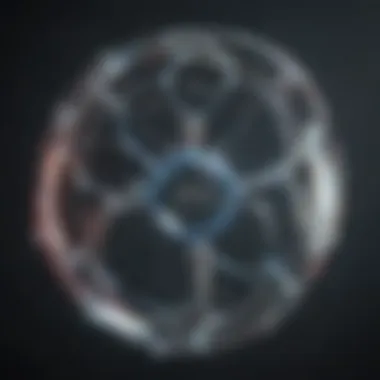Exploring the Multifaceted Uses of Lithium Chloride


Intro
Lithium chloride is a compound with relevance across multiple scientific domains. It holds substantial interest in chemistry, pharmacology, and environmental science. A nuanced understanding of its properties and applications provides insight into its importance. The examination of lithium chloride is not merely academic; it intersects with practical applications that impact daily life and industry.
Research Background
Overview of the Scientific Problem Addressed
The study of lithium chloride addresses several critical scientific questions. Key among these is the compound's interactions at a molecular level and how these interactions influence its vast potential applications. Lithium chloride displays unique chemical characteristics that propel its use in various fields, including its role as a desiccant in industrial processes and its potential therapeutic effects in medicine.
Historical Context and Previous Studies
Historically, lithium compounds have been of interest since the late 19th century. The significance of lithium chloride emerged with the discovery of lithium’s mood-stabilizing properties in the mid-20th century. Numerous studies have been conducted over the decades, documenting its chemical behavior, synthesis, and environmental implications. Noteworthy research includes examining its efficacy in treating bipolar disorder as well as its operational efficiency in electrochemical cells.
Findings and Discussion
Key Results of the Research
Research indicates that lithium chloride has multiple roles that extend beyond simple applications. Its hygroscopic nature allows it to absorb moisture from the air, which makes it a valuable material for drying applications. In the pharmaceutical realm, it has been observed to exhibit unique ion-conducting properties critical for electrochemical devices.
Interpretation of the Findings
The findings suggest that lithium chloride's utility is linked to both its chemical structure and its interaction with other substances. Its ability to form stable solutions with various organic solvents positions it as an exceptional agent in both industrial and research settings. When looking at its environmental impact, understanding its behavior in various contexts can illuminate potential risks and benefits associated with its use.
"Lithium chloride's significance cannot be understated; it connects various scientific threads from medicine to environmental science."
Prelims to Lithium Chloride
Lithium chloride is a compound of increasing significance in both research and industry. Its unique characteristics and applications make it a focal point of inquiry among scientists and manufacturers alike. Understanding lithium chloride is essential because it offers insights into both its behavior and potential uses in various fields. This article will address the multifaceted nature of lithium chloride, exploring its properties, synthesis, and practical applications.
Overview of Lithium Chloride
Lithium chloride is an inorganic salt, with the chemical formula LiCl. It exists as a white or colorless crystalline solid. This compound is hygroscopic, which means it has a strong affinity for water. This property makes lithium chloride essential in various moisture control applications. In its low-density state, lithium chloride can dissolve in water efficiently, producing a solution that is often used in chemical syntheses. Its solubility is particularly notable compared to other lithium salts.
The compound can be produced through several methods, including direct synthesis from its elements and from lithium hydroxide and hydrochloric acid. Being a binary salt, lithium chloride is a product of the reaction between lithium and chlorine, which contributes to its unique behavior in solutions.
Importance in Scientific Research
Lithium chloride is widely studied in various scientific domains. Its applications range from medicine to environmental science. In pharmaceuticals, lithium compounds are vital in the treatment of mood disorders like bipolar disorder. These applications have sparked numerous studies exploring lithium chloride's implications in health and well-being.
Beyond clinical uses, lithium chloride has found a role as a solvent in chemical reactions. The compound acts in ways that can influence reaction rates and outcomes, making it a subject of interest in organic chemistry. Furthermore, due to its ability to form stable complexes with organic compounds, lithium chloride is critical in the development of electrolyte solutions for batteries.


"The potential of lithium chloride extends beyond existing applications, inviting researchers to explore innovative uses in energy storage and material science."
As environmental concerns grow, lithium chloride is also being examined for its environmental impact and processes for recycling. Researchers are investigating sustainable ways to handle lithium chloride waste and restore natural habitats that may have been affected by its production or disposal. This underscores its relevance in addressing contemporary ecological challenges.
Chemical Properties
Understanding the chemical properties of lithium chloride is essential for grasping its significance in various domains, ranging from pharmacology to materials science. Chemical properties provide insight into how lithium chloride interacts with other compounds and environmental factors. Such insights are necessary for developing applications and technologies that effectively utilize this compound.
Molecular Structure
Lithium chloride has the formula LiCl, representing a simple ionic structure. The lithium ion (Li⁺) and the chloride ion (Cl⁻) combine to form a stable ionic lattice. This lattice structure is crucial as it dictates many of the compound's behaviors, particularly its solubility and ionic conductivity. The bond length between lithium and chlorine is approximately 2.02 Å. The placement of these ions influences how lithium chloride interacts in aqueous solutions and within solid states.
Physical Properties
Lithium chloride presents several notable physical characteristics. It is a white crystalline solid at room temperature. The melting point is 606 °C, while it has a boiling point of 1382 °C. These high temperatures indicate strong ionic bonds that require significant energy to break. Additionally, lithium chloride is highly soluble in water, which makes it useful in various chemical reactions and applications. Its solubility also factors into its role in managing thermal dynamics in systems such as cooling and heating. Furthermore, when dissolved, lithium chloride dissociates into lithium and chloride ions, enhancing its conductivity, which is a key feature for electrochemical applications.
Chemical Stability
Lithium chloride exhibits a remarkable degree of chemical stability under standard conditions. The compound remains stable in both solid and aqueous forms, and it does not readily react with water or atmospheric moisture. However, when exposed to extreme conditions, such as high temperatures or specific chemical agents, it may undergo decomposition or form new compounds. For example, it can interact with other alkali chlorides under certain conditions. Understanding these stability aspects is vital for industries that rely on lithium chloride for production and research activities. Its stability makes it suitable for long-term storage and use in sensitive environments without frequent degradation.
The detailed study of chemical properties aids in the development of reliable methodologies to harness lithium chloride in various applications.
By delving into molecular structure, physical properties, and stability, we can appreciate the essential facets of lithium chloride. These properties decode the behavior of lithium chloride in practical applications, guiding researchers and industry professionals alike in their endeavors.
Synthesis of Lithium Chloride
The synthesis of lithium chloride is a critical aspect of its study, as the methods employed in its production greatly influence both its quality and application. Understanding the synthesis processes allows researchers and professionals to optimize the production parameters in various settings, from small-scale labs to large industrial contexts. This knowledge is essential not only for enhancing product yield but also for ensuring environmental and economic sustainability in manufacturing practices.
Manufacturing Methods
Lithium chloride can be synthesized through several methods, each with its own advantages and disadvantages. Here are the most common approaches:
- Direct Reaction: Lithium carbonate can be reacted with hydrochloric acid. This method is straightforward and often preferred for its simplicity.
- Solvated Fusion: Mixing lithium hydroxide with sodium chloride, involves heating the mixture. This process yields lithium chloride while also removing sodium ions. This method can produce high purity lithium chloride.
- Electrolytic Process: Involves the electrolysis of a lithium chloride solution. This technique is more complex and costly but can be beneficial for large-scale production.
Each of these methods has distinct benefits. For example, the direct reaction allows for a rapid synthesis, while the solvated fusion method ensures a robust yield of high-purity lithium chloride. When selecting a method, considerations must include not just efficiency but also the environmental impact of the process.
Reactions Involved
The reactions involved in producing lithium chloride, particularly the direct reaction with hydrochloric acid, can be described by the following chemical equation:
This equation shows the conversion of lithium carbonate and hydrochloric acid into lithium chloride, along with water and carbon dioxide as byproducts. The management of these byproducts is crucial for minimizing environmental impact. Moreover, efficient gas handling systems must be in place for the safe removal of carbon dioxide generated during the process.


Important Note: Careful control of reaction conditions, such as temperature and concentrations, can significantly impact the quality of lithium chloride produced.
In summary, the synthesis of lithium chloride is multifaceted, with various methods and reactions contributing to its overall production. As industries and researchers seek more efficient, cost-effective, and sustainable production practices, understanding these processes becomes ever more vital.
Applications in Industry
Lithium chloride has a diverse range of applications across various industries. Its unique chemical properties provide essential benefits, making it a valuable component in many sectors. The relevance of lithium chloride in industrial applications can be observed in pharmaceuticals, electrochemical systems, and climate control technologies.
Lithium Chloride in Pharmaceuticals
Lithium chloride plays a crucial role in the pharmaceutical industry, particularly in the treatment of mental health conditions. It is a primary ingredient in certain medications used to manage bipolar disorder. Lithium salts, including lithium carbonate and lithium chloride, help stabilize mood and reduce the severity of manic episodes. Researchers have been exploring the mechanisms of action of lithium, highlighting its neuroprotective effects.
The formulation of these medications often requires precise dosages, making lithium chloride significant in ensuring efficacy. Careful monitoring of lithium levels in the body is vital to avoid toxicity. Thus, pharmaceutical companies emphasize rigorous testing and quality controls in producing lithium chloride-based medications.
Role in Electrochemical Cells
In the realm of electrochemistry, lithium chloride is indispensable. It serves as an electrolyte in certain types of batteries, particularly lithium-ion batteries. These batteries are widely used in consumer electronics, electric vehicles, and renewable energy storage solutions. The performance and longevity of lithium-ion batteries can be significantly enhanced by the inclusion of lithium chloride.
The presence of lithium chloride impacts the electrochemical reactions that occur within the cells. Its ability to stabilize the battery's charge and discharge cycles is particularly beneficial. This characteristic positions lithium chloride as a pivotal element in advancing energy storage technologies, aligning with growing sustainable energy initiatives.
Use in Air Conditioning Systems
Lithium chloride is also relevant in air conditioning and refrigeration systems. It is commonly utilized in desiccant dehumidifiers. These systems help maintain indoor air quality by reducing humidity levels. Lithium chloride's hygroscopic nature allows it to absorb moisture effectively, making it suitable for applications where humidity control is vital.
Using lithium chloride in these systems can lead to increased energy efficiency. By optimizing the humidity levels, air conditioning systems can operate more effectively, leading to energy savings and improved comfort.
Environmental Impact
The environmental impact of lithium chloride is a significant aspect that requires careful consideration. Understanding its effects is essential for evaluating not only its benefits in scientific applications but also its potential risks. Since lithium chloride is used in various industries and research, its handling and disposal can have far-reaching implications on ecosystems and human health.
Toxicity and Safety Concerns
Lithium chloride, while useful, poses certain toxicity risks, particularly when mishandled. When ingested or improperly exposed, it can lead to both acute and chronic health effects. The primary concerns revolve around its potential to cause neurotoxicity and renal impairment. Additionally, environmental contamination can arise from improper disposal methods, leading to soil and water pollution.
Key toxicity factors include:
- High Salinity: This can disrupt aquatic ecosystems, leading to decreased biodiversity.
- Chronic Exposure: Long-term exposure to lithium compounds may result in mental health issues, particularly in sensitive populations.
- Waste Leachate: Improper waste management can allow lithium chloride to leach into groundwater.
Therefore, safety protocols must be established. The use of personal protective equipment (PPE) is essential in laboratory settings. Proper training on handling lithium chloride safely cannot be overstated.
"Understanding the toxicity and ensuring proper safety protocols can mitigate the environmental harm caused by lithium chloride."


Recycling and Waste Management
In terms of waste management, lithium chloride recycling remains an underexplored area. Efficient recycling methods are essential to minimize environmental impact and enhance sustainability. This is particularly important in industries where lithium chloride is extensively utilized, such as in lithium-ion batteries, where waste generation is significant.
Considerations for recycling and waste management include:
- Beneficial Reuse: Efforts should focus on reusing lithium chloride from industrial processes, reducing the need for new raw materials.
- Safe Disposal Practices: Any contaminated waste must be appropriately treated to prevent environmental contamination.
- Resource Recovery: Establishing facilities that efficiently recover lithium chloride can reduce landfill usage and environmental degradation.
Overall, proactive recycling and waste management strategies can reduce the overall environmental footprint of lithium chloride. Without proper attention to these aspects, its benefits in various applications could be overshadowed by negative environmental repercussions.
Future Directions in Research
In recent years, research on lithium chloride has expanded significantly, highlighting its versatile applications and potential new functionalities. Understanding future directions in research is critical for various fields, including chemistry, materials science, and environmental science. This section discusses emerging trends and focuses on specific innovations that may influence the direction of lithium chloride applications and research.
Innovations in Lithium Chloride Applications
Innovations in lithium chloride applications are manifold. Researchers are exploring its use in advanced energy storage systems, specifically in solid-state batteries. Lithium chloride can enhance the electrochemical properties in these batteries, resulting in higher energy density and greater stability. This innovation stands to impact the electric vehicle market significantly, where improving battery efficiency is crucial.
Additionally, researchers are considering lithium chloride for use in thermal storage systems. Incorporating it into systems designed for concentrated solar power may optimize energy capture and storage, presenting a sustainable approach to energy management.
Moreover, advancements in materials science are exploring the synthesis of hybrid materials integrating lithium chloride with graphene. These composites could exhibit remarkable electrical properties and be applicable in sensors and electronic devices. Routine testing and application of these techniques may unveil new possibilities for lithium chloride as a functional material in modern technology.
Potential New Uses
The potential new uses of lithium chloride may extend beyond its current applications. One promising area of research is in the biomedical field. Studies suggest lithium chloride may play a role in neuroprotective therapies. Understanding how lithium chloride interacts with cellular processes could lead to novel treatments for neurodegenerative diseases, including Alzheimer's and Parkinson's.
In addition, its hygroscopic properties make lithium chloride an interesting candidate for humidity control in various environments. This property allows it to absorb moisture from the air effectively, which could be useful in preventing corrosion in historical buildings or protecting sensitive electronic equipment.
Furthermore, lithium chloride may have applications in the production of room-temperature ionic liquids. These liquids have potential uses in green chemistry, providing non-toxic alternative solvents that are less harmful to the environment. By exploring these avenues, researchers may unlock new dimensions for lithium chloride, establishing its relevance in emerging technologies.
"The exploration of lithium chloride's potential uses could define new paradigms in research and industry, propelling innovation forward."
In summary, the future directions in lithium chloride research are not just exciting but vital for its meaningful application across different sectors. The continuous exploration of its properties and potential studies may contribute significantly to advancements in materials and biomedical sciences. By investing in necessary research, markets can harness the full capabilities of lithium chloride to address contemporary challenges.
Closure
In this conclusion, we reflect on the significance of lithium chloride in various fields and its future trajectory. This article has explored lithium chloride’s unique properties, synthesis methods, and diverse applications. Understanding these elements is crucial for researchers and professionals alike.
Lithium chloride holds a pivotal role, especially in pharmaceuticals and electrochemical systems. Its specific characteristics, such as hygroscopicity and thermal stability, render it valuable for applications ranging from mood stabilization in psychiatric treatments to enhancing battery performance in modern energy solutions.
Summary of Key Points
- Lithium chloride is a unique chemical compound with distinct properties relevant to both scientific research and industrial applications.
- Its role in pharmaceuticals highlights its importance in mental health treatment, providing essential therapeutic benefits.
- As lithium-ion batteries expand in popularity, lithium chloride will continue to contribute to advancements in energy storage technology.
- Environmental considerations, including safety and recycling, are critical in the ongoing discussions surrounding lithium chloride usage.
"The future of lithium chloride will be shaped by innovations and an increasing understanding of its impacts on both health and technology."
Final Thoughts on Lithium Chloride
As we have discussed, lithium chloride is more than just a chemical compound; it is a catalyst for change across multiple disciplines. The ongoing research into its applications and impacts emphasizes the necessity of a multidisciplinary approach. Researchers need to balance the benefits of lithium chloride with potential risks, ensuring sustainable practices in its use. Understanding this compound opens doors to new possibilities, shaping a future where its applications can be optimized for greater efficiency and safety. By staying informed and engaged, the scientific community can harness the potential of lithium chloride for innovative solutions.







